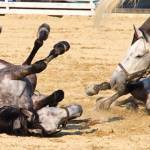Caring for Minor Skin Wounds in Horses

Whether they are in the barn or at pasture, horses seem prone to acquiring small cuts and scrapes on a regular basis. Even if owners are faithful about routinely checking stall walls and fences for nails, sharp edges, and protruding objects, equines can find something to bump. Horses turned out in groups may accumulate minor injuries as they interact, biting and kicking each other in aggression or play.
Most of these injuries heal with minimal treatment, but it’s important for owners to check horses regularly for small wounds. This can easily be done during the daily grooming when the owner has a chance to look the horse over, including places that are somewhat hard to see like under the belly and on the inner surfaces of the hind legs.
Even a small scrape should be flushed with clean water or saline solution to remove material such as dirt or grass that is sticking to the raw area. Washing will also remove some bacteria that are certainly present, even if they can’t be seen. A thorough rinse with hosed tap water is easiest; saline solution in handy squirt bottles can be purchased at a drug store and is ready to use when access to water is difficult, such as in the middle of a long trail ride.
Owners should examine any wound carefully to be sure it is as clean as possible before applying an antibiotic gel or cream. Small wounds usually don’t need to be bandaged, and most will heal without problems. Larger cuts, puncture wounds, and any significant injuries on the lower legs should probably be checked by a veterinarian. These wounds need to be watched carefully as they heal, and a veterinarian may need to make a second visit if infection is present or proud flesh begins to form.








